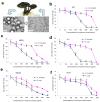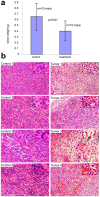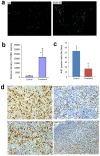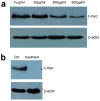Anticancer activity of Amauroderma rude
- PMID: 23840494
- PMCID: PMC3688780
- DOI: 10.1371/journal.pone.0066504
Anticancer activity of Amauroderma rude
Abstract
More and more medicinal mushrooms have been widely used as a miraculous herb for health promotion, especially by cancer patients. Here we report screening thirteen mushrooms for anti-cancer cell activities in eleven different cell lines. Of the herbal products tested, we found that the extract of Amauroderma rude exerted the highest activity in killing most of these cancer cell lines. Amauroderma rude is a fungus belonging to the Ganodermataceae family. The Amauroderma genus contains approximately 30 species widespread throughout the tropical areas. Since the biological function of Amauroderma rude is unknown, we examined its anti-cancer effect on breast carcinoma cell lines. We compared the anti-cancer activity of Amauroderma rude and Ganoderma lucidum, the most well-known medicinal mushrooms with anti-cancer activity and found that Amauroderma rude had significantly higher activity in killing cancer cells than Ganoderma lucidum. We then examined the effect of Amauroderma rude on breast cancer cells and found that at low concentrations, Amauroderma rude could inhibit cancer cell survival and induce apoptosis. Treated cancer cells also formed fewer and smaller colonies than the untreated cells. When nude mice bearing tumors were injected with Amauroderma rude extract, the tumors grew at a slower rate than the control. Examination of these tumors revealed extensive cell death, decreased proliferation rate as stained by Ki67, and increased apoptosis as stained by TUNEL. Suppression of c-myc expression appeared to be associated with these effects. Taken together, Amauroderma rude represented a powerful medicinal mushroom with anti-cancer activities.
Conflict of interest statement
Figures









References
-
- Lin ZB (2001) [The integrated studies on Ganoderma lucidum Kayst. Guided by Traditional Chinese medical theories]. Zhongguo Zhong Xi Yi Jie He Za Zhi 21: 883–884. - PubMed
-
- Maruyama H, Yamazaki K, Murofushi S, Konda C, Ikekawa T (1989) Antitumor activity of Sarcodon aspratus (Berk.) S. Ito and Ganoderma lucidum (Fr.) Karst. J Pharmacobiodyn 12: 118–123. - PubMed
-
- Eo SK, Kim YS, Lee CK, Han SS (1999) Antiherpetic activities of various protein bound polysaccharides isolated from Ganoderma lucidum. J Ethnopharmacol 68: 175–181. - PubMed
-
- Gao Y, Zhou S, Wen J, Huang M, Xu A (2002) Mechanism of the antiulcerogenic effect of Ganoderma lucidum polysaccharides on indomethacin-induced lesions in the rat. Life Sci 72: 731–745. - PubMed
-
- Hsu MJ, Lee SS, Lin WW (2002) Polysaccharide purified from Ganoderma lucidum inhibits spontaneous and Fas-mediated apoptosis in human neutrophils through activation of the phosphatidylinositol 3 kinase/Akt signaling pathway. J Leukoc Biol 72: 207–216. - PubMed
Publication types
MeSH terms
Substances
Grants and funding
LinkOut - more resources
Full Text Sources
Other Literature Sources
Medical

